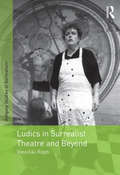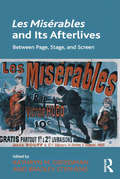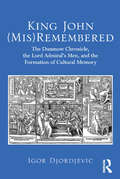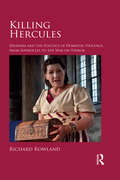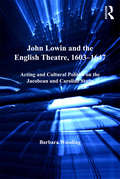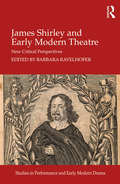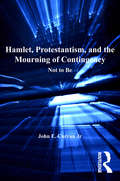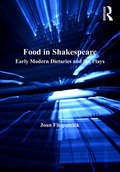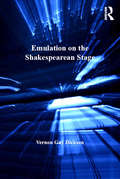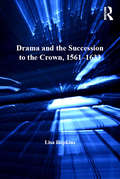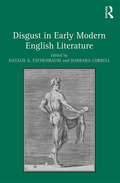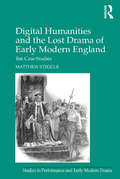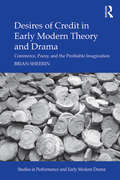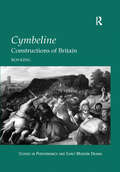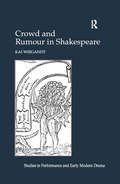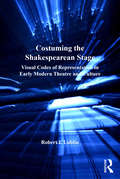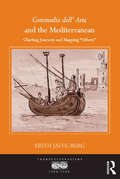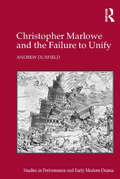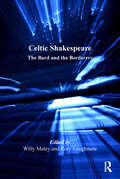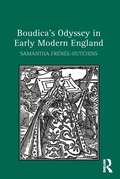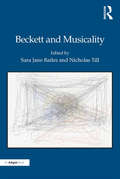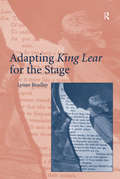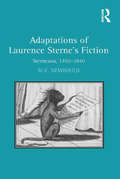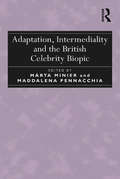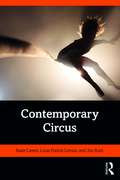- Table View
- List View
Ludics in Surrealist Theatre and Beyond (Studies in Surrealism)
by Vassiliki RaptiTaking as its point of departure the complex question about whether Surrealist theatre exists, this book re-examines the much misunderstood artistic medium of theatre within Surrealism, especially when compared to poetry and painting. This study reconsiders Surrealist theatre specifically from the perspective of ludics-a poetics of play and games-an ideal approach to the Surrealists, whose games blur the boundaries between the 'playful' and the 'serious.' Vassiliki Rapti's aims are threefold: first, to demystify André Breton's controversial attitude toward theatre; second, to do justice to Surrealist theatre, by highlighting the unique character that derives from its inherent element of play; and finally, to trace the impact of Surrealist theatre in areas far beyond its generally acknowledged influence on the Theatre of the Absurd-an impact being felt even on the contemporary world stage. Beginning with the Surrealists' 'one-into-another' game and its illustration of Breton's ludic dramatic theory, Rapti then examines the traces of this kind of game in the works of a wide variety of Surrealist and Post-Surrealist playwrights and stage directors, from several different countries, and from the 1920s to the present: Roger Vitrac, Antonin Artaud, Günter Berghaus, Nanos Valaoritis, Robert Wilson, and Megan Terry.
Les Misérables and Its Afterlives: Between Page, Stage, and Screen
by Kathryn M. Grossman Bradley StephensExploring the enduring popularity of Victor Hugo’s Les Misérables, this collection offers analysis of both the novel itself and its adaptations. In spite of a mixed response from critics, Les Misérables instantly became a global bestseller. Since its successful publication over 150 years ago, it has traveled across different countries, cultures, and media, giving rise to more than 60 international film and television variations, numerous radio dramatizations, animated versions, comics, and stage plays. Most famously, it has inspired the world's longest running musical, which itself has generated a wealth of fan-made and online content. Whatever its form, Hugo’s tale of social injustice and personal redemption continues to permeate the popular imagination. This volume draws together essays from across a variety of fields, combining readings of Les Misérables with reflections on some of its multimedia afterlives, including musical theater and film from the silent period to today's digital platforms. The contributors offer new insights into the development and reception of Hugo's celebrated classic, deepening our understanding of the novel as a work that unites social commentary with artistic vision and raising important questions about the cultural practice of adaptation.
King John (Mis)Remembered: The Dunmow Chronicle, The Lord Admiral's Men, And The Formation Of Cultural Memory
by Igor DjordjevicKing John’s evil reputation has outlasted and proved more enduring than that of Richard III, whose notoriety seemed ensured thanks to Shakespeare’s portrayal of him. The paradox is even greater when we realize that this portrait of John endures despite Shakespeare’s portrait of him in the play King John, where he hardly comes off as a villain at all. Here Igor Djordjevic argues that the story of John’s transformation in cultural memory has never been told completely, perhaps because the crucial moment in John’s change back to villainy is a literary one: it occurs at the point when the 'historiographic' trajectory of John’s character-development intersects with the 'literary' evolution of Robin Hood. But as Djordjevic reveals, John’s second fall in cultural memory became irredeemable as the largely unintended result of the work of three men - John Stow, Michael Drayton, Anthony Munday - who knew each other and who all read a significant passage in a little known book (the Chronicle of Dunmow), while a fourth man’s money (Philip Henslowe) helped move the story from page to stage. The rest, as they say, is history. Paying particular attention to the work of Michael Drayton and Anthony Munday who wrote for the Lord Admiral’s Men, Djordjevic traces the cultural ripples their works created until the end of the seventeenth century, in various familiar as well as previously ignored historical, poetic, and dramatic works by numerous authors. Djordjevic’s analysis of the playtexts’ source, and the personal and working relationship between the playwright-poets and John Stow as the antiquarian disseminator of the source text, sheds a brighter light on a moment that proves to have a greater significance outside theatrical history; it has profound repercussions for literary history and a nation’s cultural memory.
Killing Hercules: Deianira and the Politics of Domestic Violence, from Sophocles to the War on Terror
by Richard RowlandThis book offers an entirely new reception history of the myth of Hercules and his wife/killer Deianira. The book poses, and attempts to answer, two important and related questions. First, why have artists across two millennia felt compelled to revisit this particular myth to express anxieties about violence at both a global and domestic level? Secondly, from the moment that Sophocles disrupted a myth about the definitive exemplar of masculinity and martial prowess and turned it into a story about domestic abuse, through to a 2014 production of Handel’s Hercules that was set in the context of the ‘war on terror’, the reception history of this myth has been one of discontinuity and conflict; how and why does each culture reinvent this narrative to address its own concerns and discontents, and how does each generation speak to, qualify or annihilate the certainties of its predecessors in order to understand, contain or exonerate the aggression with which their governors – of state and of the household – so often enforce their authority, and the violence to which their nations, and their homes, are perennially vulnerable?
John Lowin and the English Theatre, 1603–1647: Acting and Cultural Politics on the Jacobean and Caroline Stage (Studies in Performance and Early Modern Drama)
by Barbara WoodingEven for scholars who have devoted their careers to the early modern theatre, the name John Lowin may not instantly evoke recognition-until now, the actor's life and contribution to the theatre of the period has never been the subject of a full-length publication. In this study, Barbara Wooding provides a comprehensive overview of the life and times of Lowin, a leader of the King's Men's Company and one of the greatest actors of the seventeenth century. She examines his involvement in the Jacobean/Caroline world as performer, citizen and company manager, and contextualizes his life and career within the socio-economic and political framework of the period. Although references to him in the archives are patchy and sporadic, information about his activities within the King's Men's Company is well documented. In the course of analysing less familiar plays of the period and the characters Lowin played in them, Wooding supplements critical understanding of the scope and range of Caroline drama. Because Lowin's career burgeoned after Shakespeare's and Burbage's death, his life in Southwark and his career with the same company furnishes the opportunity for an examination of the changing status of actors, and the exercising of their skills within the drama of the later playhouse period.
James Shirley and Early Modern Theatre: New Critical Perspectives (Studies in Performance and Early Modern Drama)
by Barbara RavelhoferJames Shirley was the last great dramatist of the English Renaissance, shining out among other luminaries such as John Ford, Ben Jonson, or Richard Brome. This collection considers Shirley within the culture of his time, and highlights his contribution to seventeenth-century English literature as poet and playwright. Individual essays explore Shirley’s musical theatre and spoken verse, performance conditions, female agency and politics, and the presentation of his work in manuscript and print. Collectively, the essays assemble a larger picture of Caroline drama, showing it to be more than simply a nostalgic endgame, its poets daintily sipping hemlock on the eve of the Civil Wars. Shirley’s literary versatility and long life, spanning the last days of Queen Elizabeth I to the ascension of Charles II, make him an ideal writer through whom to examine the distinctive qualities of Caroline theatre.
Hamlet, Protestantism, and the Mourning of Contingency: Not to Be
by John E. JrBuilding on current scholarly interest in the religious dimensions of the play, this study shows how Shakespeare uses Hamlet to comment on the Calvinistic Protestantism predominant around 1600. By considering the play's inner workings against the religious ideas of its time, John Curran explores how Shakespeare portrays in this work a completely deterministic universe in the Calvinist mode, and, Curran argues, exposes the disturbing aspects of Calvinism. By rendering a Catholic Prince Hamlet caught in a Protestant world which consistently denies him his aspirations for a noble life, Shakespeare is able in this play, his most theologically engaged, to delineate the differences between the two belief systems, but also to demonstrate the consequences of replacing the old religion so completely with the new.
Food in Shakespeare: Early Modern Dietaries and the Plays (Literary And Scientific Cultures Of Early Modernity Ser.)
by Joan FitzpatrickA study of common and exotic food in Shakespeare's plays, this is the first book to explore early modern English dietary literature to understand better the significance of food in Shakespearean drama. Food in Shakespeare provides for modern readers and audiences an historically accurate account of the range of, and conflicts between, contemporary ideas that informed the representations of food in the plays. It also focuses on the social and moral implications of familiar and strange foodstuff in Shakespeare's works. This new approach provides substantial fresh readings of Hamlet, Macbeth, As you Like It, The Winter's Tale, Henry IV Parts 1 and 2, Henry V, Titus Andronicus, Coriolanus, Pericles, Timon of Athens, and the co-authored Sir Thomas More. Among the dietaries explored are Andrew Boorde's A Compendyous Regyment or a Dyetary of Healthe (1547), William Bullein's The Gouernement of Healthe (1595), Thomas Elyot's The Castle of Helthe (1595) and Thomas Cogan's The Hauen of Health (1636). These dieteries were republished several times in the early modern period; together they typify the genre's condemnation of surfeit and the tendency to blame human disease on feeding practices. This study directs scholarly attention to the importance of early modern dietaries, analyzing their role in wider culture as well as their intersection with dramatic art. In the dietaries food and drink are indices of one's position in relation to complex ideas about rank, nationality, and spiritual well-being; careful consumption might correct moral as well as physical shortcomings. The dietaries are an eclectic genre: some contain recipes for the reader to try, others give tips on more general lifestyle choices, but all offer advice on how to maintain good health via diet. Although some are more stern and humourless than others, the overwhelming impression is that of food as an ally in the battle against disease and ill-health as well as a potential enemy.
Emulation on the Shakespearean Stage (Studies in Performance and Early Modern Drama)
by Vernon Guy DicksonThe English Renaissance has long been considered a period with a particular focus on imitation; however, much related scholarship has misunderstood or simply marginalized the significance of emulative practices and theories in the period. This work uses the interactions of a range of English Renaissance plays with ancient and Renaissance rhetorics to analyze the conflicted uses of emulation in the period (including the theory and praxis of rhetorical imitatio, humanist notions of exemplarity, and the stage’s purported ability to move spectators to emulate depicted characters). This book emphasizes the need to see emulation not as a solely (or even primarily) literary practice, but rather as a significant aspect of Renaissance culture, giving insight into notions of self, society, and the epistemologies of the period and informed by the period’s own sense of theory and history. Among the individual texts examined here are Shakespeare’s Titus Andronicus and Hamlet, Jonson’s Catiline, and Massinger’s The Roman Actor (with its strong relation to Jonson’s Sejanus).
Drama and the Succession to the Crown, 1561-1633 (Studies In Performance And Early Modern Drama Ser.)
by Lisa HopkinsThe succession to the throne, Lisa Hopkins argues here, was a burning topic not only in the final years of Elizabeth but well into the 1630s, with continuing questions about how James's two kingdoms might be ruled after his death. Because the issue, with its attendant constitutional questions, was so politically sensitive, Hopkins contends that drama, with its riddled identities, oblique relationship to reality, and inherent blurring of the extent to which the situation it dramatizes is indicative or particular, offered a crucial forum for the discussion. Hopkins analyzes some of the ways in which the dramatic works of the time - by Marlowe, Shakespeare, Webster and Ford among others - reflect, negotiate and dream the issue of the succession to the throne.
Disgust in Early Modern English Literature
by Natalie K. Eschenbaum Barbara CorrellWhat is the role of disgust or revulsion in early modern English literature? How did early modern English subjects experience revulsion and how did writers represent it in poetry, plays, and prose? What does it mean when literature instructs, delights, and disgusts? This collection of essays looks at the treatment of disgust in texts by Spenser, Shakespeare, Donne, Jonson, Herrick, and others to demonstrate how disgust, perhaps more than other affects, gives us a more complex understanding of early modern culture. Dealing with descriptions of coagulated eye drainage, stinky leeks, and blood-filled fleas, among other sensational things, the essays focus on three kinds of disgusting encounters: sexual, cultural, and textual. Early modern English writers used disgust to explore sexual mores, describe encounters with foreign cultures, and manipulate their readers' responses. The essays in this collection show how writers deployed disgust to draw, and sometimes to upset, the boundaries that had previously defined acceptable and unacceptable behaviors, people, and literatures. Together they present the compelling argument that a critical understanding of early modern cultural perspectives requires careful attention to disgust.
Digital Humanities and the Lost Drama of Early Modern England: Ten Case Studies (Studies in Performance and Early Modern Drama)
by Matthew SteggleThis book establishes new information about the likely content of ten lost plays from the period 1580-1642. These plays’ authors include Nashe, Heywood, and Dekker; and the plays themselves connect in direct ways to some of the most canonical dramas of English literature, including Hamlet, King Lear, The Changeling, and The Duchess of Malfi. The lost plays in question are: Terminus & Non Terminus (1586-8); Richard the Confessor (1593); Cutlack (1594); Bellendon (1594); Truth's Supplication to Candlelight (1600); Albere Galles (1602); Henry the Una (c. 1619); The Angel King (1624); The Duchess of Fernandina (c. 1630-42); and The Cardinal's Conspiracy (bef. 1639). From this list of bare titles, it is argued, can be reconstructed comedies, tragedies, and histories, whose leading characters included a saint, a robber, a Medici duchess, an impotent king, at least one pope, and an angel. In each case, newly-available digital research resources make it possible to interrogate the title and to identify the play's subject-matter, analogues, and likely genre. But these concrete examples raise wider theoretical problems: What is a lost play? What can, and cannot, be said about objects in this problematic category? Known lost plays from the early modern commercial theatre outnumber extant plays from that theatre: but how, in practice, can one investigate them? This book offers an innovative theoretical and practical frame for such work, putting digital humanities into action in the emerging field of lost play studies.
Desires of Credit in Early Modern Theory and Drama: Commerce, Poesy, and the Profitable Imagination (Studies in Performance and Early Modern Drama)
by Brian SheerinDesires of Credit in Early Modern Theory and Drama traces the near-simultaneous rise of economic theory, literary criticism, and public theater in London at the turn of the seventeenth century, and posits that connecting all three is a fascination with creating something out of nothing simply by acting as if it were there. Author Brian Sheerin contends that the motivating force behind both literary and economic inquiry at this time was the same basic quandary about the human imagination--specifically, how investments of belief can produce tangible consequences. Just as speculators were realizing the potency of collective imagination on economic circulation, readers and dramatists were becoming newly introspective about whether or not the 'lies' of literature could actually be morally 'profitable.' Could one actually benefit by taking certain fictions 'seriously'? Each of the five chapters examines a different dimension of this question by highlighting a particular dramatization of economic trust on the Renaissance stage, in plays by Marlowe, Shakespeare, Heywood, Dekker, and Jonson. The book fills a gap in current scholarship by keeping economic and dramatic interests rigorously grounded in early modern literary criticism, but also by emphasizing the productive nature of debt in a way that resonates with recent economic sociology.
Cymbeline: Constructions of Britain (Studies in Performance and Early Modern Drama)
by Ros KingIn Cymbeline: Constructions of Britain, Ros King argues that because of previous misunderstanding of the nature and history of tragi-comedy, critics have mistaken the tone of Shakespeare's play. Although it is often dismissed as a pedestrian 'romance', or at best a self-parodic reworking of previous Shakespearean themes, she proposes that Cymbeline's fantastical, black comedy and its facility for keeping multiple plots all in the air together are in fact a tour de force of dramaturgical construction. King's multi-faceted approach combines strikingly perceptive commentaries on the text's most notoriously difficult passages, with descriptions of performance, and analysis of the text's historical, cultural and literary contexts. In this wide-ranging study, the play becomes a focus for considering early modern England's encounters with its Scottish king, with religious struggle in Europe, and with the indigenous peoples of North America. King demonstrates that the play's dramaturgical structure enables it to raise daring questions about the nature of government, the rights of birth and of succession, and the concepts of 'empire', supplying a curiously bitter and indeed tragic undercurrent to the final 'happy' ending while attempting to neutralise contemporary religious conflict. Having explored the influences that went into the writing of Cymbeline, King devotes her final chapter to the play's later reception and shows how it has been made to respond to different cultural pressures over time. Using as a test case the outrageously ebullient production at Shakespeare Santa Cruz, 2000, for which she was dramaturg, she outlines an ethic for interpretation and considers the problems to be faced in both criticism and performance when realising the text as living theatre for a modern audience.
Crowd and Rumour in Shakespeare (Studies in Performance and Early Modern Drama)
by Kai WiegandtIn this study, the author offers new interpretations of Shakespeare's works in the context of two major contemporary notions of collectivity: the crowd and rumour. The plays illustrate that rumour and crowd are mutually dependent; they also betray a fascination with the fact that crowd and rumour make individuality disappear. Shakespeare dramatizes these mechanisms, relating the crowd to class conflict, to rhetoric, to the theatre and to the organization of the state; and linking rumour to fear, to fame and to philosophical doubt. Paying attention to all levels of collectivity, Wiegandt emphasizes the close relationship between the crowd onstage and the Elizabethan audience. He argues that there was a significant - and sometimes precarious - metatheatrical blurring between the crowd on the stage and the crowd around the stage in performances of crowd scenes. The book's focus on crowd and rumour provides fresh insights on the central problems of some of Shakespeare's most contentiously debated plays, and offers an alternative to the dominant tradition of celebrating Shakespeare as the origin of modern individualism.
Costuming the Shakespearean Stage: Visual Codes of Representation in Early Modern Theatre and Culture (Studies In Performance And Early Modern Drama Ser.)
by Robert I. LublinAlthough scholars have long considered the material conditions surrounding the production of early modern drama, until now, no book-length examination has sought to explain what was worn on the period's stages and, more importantly, how articles of apparel were understood when seen by contemporary audiences. Robert Lublin's new study considers royal proclamations, religious writings, paintings, woodcuts, plays, historical accounts, sermons, and legal documents to investigate what Shakespearean actors actually wore in production and what cultural information those costumes conveyed. Four of the chapters of Costuming the Shakespearean Stage address 'categories of seeing': visually based semiotic systems according to which costumes constructed and conveyed information on the early modern stage. The four categories include gender, social station, nationality, and religion. The fifth chapter examines one play, Thomas Middleton's A Game at Chess, to show how costumes signified across the categories of seeing to establish a play's distinctive semiotics and visual aesthetic.
Commedia dell' Arte and the Mediterranean: Charting Journeys and Mapping 'Others' (Transculturalisms, 1400-1700)
by Erith Jaffe-BergDrawing on published collections and also manuscripts from Mantuan archives, Commedia dell' arte and the Mediterranean locates commedia dell' arte as a performance form reflective of its cultural crucible in the Mediterranean. The study provides a broad perspective on commedia dell’ arte as an expression of the various cultural, gender and language communities in Italy during the early-modern period, and explores the ways in which the art form offers a platform for reflection on power and cultural exchange. While highlighting the prevalence of Mediterranean crossings in the scenarios of commedia dell' arte, this book examines the way in which actors embodied characters from across the wider Mediterranean region. The presence of Mediterranean minority groups such as Arabs, Armenians, Jews and Turks within commedia dell' arte is marked on stage and 'backstage' where they were collaborators in the creative process. In addition, gendered performances by the first female actors participated in 'staging' the Mediterranean by using the female body as a canvas for cartographical imaginings. By focusing attention on the various communities involved in the making of theatre, a central preoccupation of the book is to question the dynamics of 'exchange' as it materialized within a spectrum inclusive of both cultural collaboration but also of taxation and coercion.
Christopher Marlowe and the Failure to Unify (Studies in Performance and Early Modern Drama)
by Andrew DuxfieldIn this sustained full length study of Marlowe's plays, Andrew Duxfield argues that Marlovian drama exhibits a marked interest in unity and unification, and that in doing so it engages with a discourse of anxiety over social discord that was prominent in the 1580s and 1590s. In combination with the ambiguity of the plays, he suggests, this focus produces a tension that both heightens dramatic effect and facilitates a cynical response to contemporary evocations of and pleas for unity. This book has three main aims. Firstly, it establishes that Marlowe’s tragedies exhibit a profound interest in the process of reduction and the ideal of unity. Duxfield shows this interest to manifest itself in different ways in each of the plays. Secondly, it identifies this interest in unity and unification as an engagement in a cultural discourse that was particularly prevalent in England during Marlowe’s writing career; during the late 1580s and early 1590s heightened inter-confessional tension, the threat and reality of foreign invasion and public puritan dissent in the form of the Marprelate controversy provoked considerable public anxiety about social discord. Thirdly, the book considers the plays’ focus on unity in relation to their marked ambiguity; throughout all of the plays, unifying ideals and reductive processes are consistently subject to renegotiation with, or undercut entirely by, the complexity and ambiguity of the dramas in which they feature. Duxfield’s focus on unity as a theme throughout the plays provides a new lens through which to examine the place of Marlowe’s work in its cultural moment.
Celtic Shakespeare: The Bard and the Borderers
by Rory LoughnaneDrawing together some of the leading academics in the field of Shakespeare studies, this volume examines the commonalities and differences in addressing a notionally 'Celtic' Shakespeare. Celtic contexts have been established for many of Shakespeare's plays, and there has been interest too in the ways in which Irish, Scottish and Welsh critics, editors and translators have reimagined Shakespeare, claiming, connecting with and correcting him. This collection fills a major gap in literary criticism by bringing together the best scholarship on the individual nations of Ireland, Scotland and Wales in a way that emphasizes cultural crossovers and crucibles of conflict. The volume is divided into three chronologically ordered sections: Tudor Reflections, Stuart Revisions and Celtic Afterlives. This division of essays directs attention to Shakespeare's transformed treatment of national identity in plays written respectively in the reigns of Elizabeth and James, but also takes account of later regional receptions and the cultural impact of the playwright's dramatic works. The first two sections contain fresh readings of a number of the individual plays, and pay particular attention to the ways in which Shakespeare attends to contemporary understandings of national identity in the light of recent history. Juxtaposing this material with subsequent critical receptions of Shakespeare's works, from Milton to Shaw, this volume addresses a significant critical lacuna in Shakespearean criticism. Rather than reading these plays from a solitary national perspective, the essays in this volume cohere in a wide-ranging treatment of Shakespeare's direct and oblique references to the archipelago, and the problematic issue of national identity.
Boudica's Odyssey in Early Modern England
by Samantha Frénée-HutchinsThis diachronic study of Boudica serves as a sourcebook of references to Boudica in the early modern period and gives an overview of the ways in which her story was processed and exploited by the different players of the times who wanted to give credence and support to their own belief systems. The author examines the different apparatus of state ideology which processed the social, religious and political representations of Boudica for public absorption and helped form the popular myth we have of Boudica today. By exploring images of the Briton warrior queen across two reigns which witnessed an act of political union and a move from English female rule (under Elizabeth I) to British/Scottish masculine rule (under James VI & I) the author conducts a critical cartography of the ways in which gender, colonialism and nationalism crystallised around this crucial historical figure. Concentrating on the original transmission and reception of the ancient texts the author analyses the historical works of Hector Boece, Raphael Holinshed and William Camden as well as the canonical literary figures of Edmund Spenser, William Shakespeare and John Fletcher. She also looks at aspects of other primary sources not covered in previous scholarship, such as Humphrey Llwyd’s Breuiary of Britayne (1573), Petruccio Ubaldini’s Le Vite delle donne illustri, del regno d’Inghilterra, e del regno di Scotia (1588) and Edmund Bolton’s Nero Caesar (1624). Furthermore, she incorporates archaeological research relating to Boudica.
Beckett and Musicality
by Sara Jane Bailes Nicholas TillDiscussion concerning the ’musicality’ of Samuel Beckett’s writing now constitutes a familiar critical trope in Beckett Studies, one that continues to be informed by the still-emerging evidence of Beckett’s engagement with music throughout his personal and literary life, and by the ongoing interest of musicians in Beckett’s work. In Beckett’s drama and prose writings, the relationship with music plays out in implicit and explicit ways. Several of his works incorporate canonical music by composers such as Schubert and Beethoven. Other works integrate music as a compositional element, in dialogue or tension with text and image, while others adopt rhythm, repetition and pause to the extent that the texts themselves appear to be ’scored’. But what, precisely, does it mean to say that a piece of prose or writing for theatre, radio or screen, is ’musical’? The essays included in this book explore a number of ways in which Beckett’s writings engage with and are engaged by musicality, discussing familiar and less familiar works by Beckett in detail. Ranging from the scholarly to the personal in their respective modes of response, and informed by approaches from performance and musicology, literary studies, philosophy, musical composition and creative practice, these essays provide a critical examination of the ways we might comprehend musicality as a definitive and often overlooked attribute throughout Beckett’s work.
Adapting King Lear for the Stage
by Lynne BradleyQuestioning whether the impulse to adapt Shakespeare has changed over time, Lynne Bradley argues for restoring a sense of historicity to the study of adaptation. Bradley compares Nahum Tate's History of King Lear (1681), adaptations by David Garrick in the mid-eighteenth century, and nineteenth-century Shakespeare burlesques to twentieth-century theatrical rewritings of King Lear, and suggests latter-day adaptations should be viewed as a unique genre that allows playwrights to express modern subject positions with regard to their literary heritage while also participating in broader debates about art and society. In identifying and relocating different adaptive gestures within this historical framework, Bradley explores the link between the critical and the creative in the history of Shakespearean adaptation. Focusing on works such as Gordon Bottomley's King Lear's Wife (1913), Edward Bond's Lear (1971), Howard Barker's Seven Lears (1989), and the Women's Theatre Group's Lear's Daughters (1987), Bradley theorizes that modern rewritings of Shakespeare constitute a new type of textual interaction based on a simultaneous double-gesture of collaboration and rejection. She suggests that this new interaction provides constituent groups, such as the feminist collective who wrote Lear's Daughters, a strategy to acknowledge their debt to Shakespeare while writing against the traditional and negative representations of femininity they see reflected in his plays.
Adaptations of Laurence Sterne's Fiction: Sterneana, 1760–1840
by Mary-Celine NewbouldExploring how readers received and responded to literary works in the long eighteenth century, M-C. Newbould focuses on the role played by Laurence Sterne’s fiction and its adaptations. Literary adaptation flourished throughout the eighteenth century, encouraging an interactive relationship between writers, readers, and artists when well-known works were transformed into new forms across a variety of media. Laurence Sterne offers a particularly dynamic subject: the immense interest provoked by The Life and Opinions of Tristram Shandy, Gentleman and A Sentimental Journey through France and Italy inspired an unrivalled number and range of adaptations from their initial publication onwards. In placing her examination of Sterneana within the context of its production, Newbould demonstrates how literary adaptation operates across generic and formal boundaries. She breaks new ground by bringing together several potentially disparate aspects of Sterneana belonging to areas of literary studies that include drama, music, travel writing, sentimental fiction and the visual. Her study is a vital resource for Sterne scholars and for readers generally interested in cultural productivity in this period.
Adaptation, Intermediality and the British Celebrity Biopic
by Márta Minier Maddalena PennacchiaBeginning with the premise that the biopic is a form of adaptation and an example of intermediality, this collection examines the multiplicity of 'source texts' and the convergence of different media in this genre, alongside the concurrent issues of fidelity and authenticity that accompany this form. The contributors focus on big and small screen biopics of British celebrities from the late twentieth and twenty-first centuries, attending to their myth-making and myth-breaking potential. Related topics are the contemporary British biopic's participation in the production and consumption of celebrated lives, and the biopic's generic fluidity and hybridity as evidenced in its relationship to such forms as the bio-docudrama. Offering case studies of film biographies of literary and cultural icons, including Elizabeth I, Elizabeth II, Diana Princess of Wales, John Lennon, Shakespeare, Jane Austen, Beau Brummel, Carrington and Beatrix Potter, the essays address how British identity and heritage are interrogated in the (re)telling and showing of these lives, and how the reimagining of famous lives for the screen is influenced by recent processes of manufacturing celebrity.
Contemporary Circus: Conversations With Creators
by Katie Lavers Louis Patrick Leroux Jon BurttIn this volume, twenty-four creators come together with three scholars to discuss Contemporary Circus, bridging the divide between practice and theory. Lavers, Leroux, and Burtt offer conversations across four key themes: Apparatus, Politics, Performers, and New Work. Extensively illustrated with fifty photos of Contemporary Circus productions, and extensively annotated, Contemporary Circus thematically groups and contextualises extracts of conversations to provide a sophisticated and wide-ranging study supported by critical theory. Of interest to both practitioners and scholars, Contemporary Circus uses the lens of ‘contestation,’ or calling things into question, to provide a portal into ways of seeing today’s circus performance. Conversations with: Lachlan Binns and Jascha Boyce (Gravity and Other Myths), Tilde Björfors (Cirkus Cirkör), Kim ‘Busty Beatz’ Bowers (Hot Brown Honey), Shana Carroll (The 7 Fingers), David Clarkson (Stalker), Philippe Decouflé (Compagnie DCA), Fez Faanana (Briefs), Mike Finch (Circus Oz), Daniele Finzi Pasca (Compagnia Finzi Pasca), Sean Gandini (Gandini Juggling), Firenza Guidi (ElanFrantoio, NoFit State Circus), Jo Lancaster and Simon Yates (Acrobat), Johann Le Guillerm (Cirque Ici), Yaron Lifschitz (Circa), Chelsea McGuffin (Company 2), Phia Ménard (Compagnie Non Nova), Jennifer Miller (Circus Amok), Adrien Mondot (Compagnie Adrien M and Claire B), Charlotte Mooney and Tina Koch (Ockham’s Razor), Philippe Petit (high wire artist), and Elizabeth Streb (STREB EXTREME ACTION).
